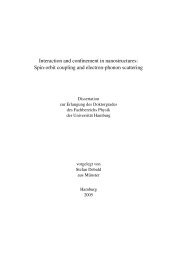Gravitinos and hidden Supersymmetry at the LHC - Universität ...
Gravitinos and hidden Supersymmetry at the LHC - Universität ...
Gravitinos and hidden Supersymmetry at the LHC - Universität ...
You also want an ePaper? Increase the reach of your titles
YUMPU automatically turns print PDFs into web optimized ePapers that Google loves.
2.1. GLOBAL SUPERSYMMETRY<br />
research will probably shift to ano<strong>the</strong>r scenarios. Therefore, it is important to look beyond<br />
st<strong>and</strong>ard scenarios <strong>and</strong> investig<strong>at</strong>e different realiz<strong>at</strong>ions of supersymmetric models, which<br />
can be <strong>hidden</strong> from <strong>the</strong> <strong>LHC</strong>. This is <strong>the</strong> main topic of <strong>the</strong> present work. In <strong>the</strong> following<br />
we will introduce our not<strong>at</strong>ions, some aspects of <strong>the</strong> formalism, <strong>and</strong> <strong>the</strong> phenomenological<br />
implic<strong>at</strong>ions of supersymmetry which will be needed in <strong>the</strong> following chapters. The discussion<br />
follows references [78,89,102,103] which contain a comprehensive introduction to <strong>the</strong>se topics.<br />
2.1 Global <strong>Supersymmetry</strong><br />
We investig<strong>at</strong>e <strong>the</strong> properties of N = 1 supersymmetry, which is <strong>the</strong> only phenomenologically<br />
interesting realiz<strong>at</strong>ion of supersymmetry in four dimensions. The supersymmetric extension<br />
of <strong>the</strong> Poincaré algebra reads:<br />
{ }<br />
Q α , Q †˙α<br />
= 2σ µ α ˙α P µ, {Q α , Q β } =<br />
{ }<br />
[ ]<br />
Q<br />
†˙α<br />
, = 0, [P Q†˙β<br />
µ , Q α ] = P µ , Q †˙α = 0. (2.2)<br />
Represent<strong>at</strong>ions Irreducible represent<strong>at</strong>ions of <strong>the</strong> supersymmetry algebra are called supermultiplets,<br />
<strong>the</strong>y unify fermionic <strong>and</strong> bosonic degrees of freedom. There are two such<br />
(massless) supermultiplets in our case, <strong>the</strong> chiral <strong>and</strong> <strong>the</strong> vector supermultiplet.<br />
The chiral multiplet contains one complex scalar φ <strong>and</strong> one two-component fermion ψ<br />
transforming in <strong>the</strong> defining represent<strong>at</strong>ion of SL(2, C), see Appendix A for details on <strong>the</strong><br />
two-component not<strong>at</strong>ion. In order for <strong>the</strong> SUSY algebra to close off-shell, <strong>the</strong> chiral multiplet<br />
is augmented with an auxiliary complex scalar F , which has no kinetic term in <strong>the</strong> full <strong>the</strong>ory.<br />
The vector supermultiplet contains one massless vector field A µ , one two-component<br />
fermion λ α transforming also as ( 1 2<br />
, 0), <strong>and</strong> off-shell a real auxiliary scalar D. Since <strong>the</strong><br />
supersymmetry gener<strong>at</strong>ors commute with <strong>the</strong> gener<strong>at</strong>ors of <strong>the</strong> gauge transform<strong>at</strong>ions, <strong>the</strong><br />
whole supermultiplet transforms in <strong>the</strong> same represent<strong>at</strong>ion of <strong>the</strong> gauge group, in particular<br />
<strong>the</strong> fermion λ transforms in <strong>the</strong> adjoint represent<strong>at</strong>ion.<br />
Superfields We have seen th<strong>at</strong> supersymmetry has a peculiar fe<strong>at</strong>ure being on <strong>the</strong> one<br />
h<strong>and</strong> an internal symmetry, <strong>and</strong> on <strong>the</strong> o<strong>the</strong>r h<strong>and</strong> an extension of <strong>the</strong> external Poincaré<br />
group. Both notions can be concili<strong>at</strong>ed if one introduces superspace as n<strong>at</strong>ural stage for<br />
supersymmetry. Superspace is obtained by adding four fermionic coordin<strong>at</strong>es to <strong>the</strong> usual<br />
bosonic space-time coordin<strong>at</strong>es. Points in superspace are labeled by coordin<strong>at</strong>es:<br />
x µ , θ α , θ<br />
†˙α<br />
. (2.3)<br />
Here θ α <strong>and</strong> θ<br />
†˙α<br />
are constant complex anticommuting two-component spinors with dimension<br />
[mass] − 1/2<br />
. The components of θ are anticommuting Grassmann numbers. The objects<br />
living in superspace are superfields, functions of <strong>the</strong> superspace coordin<strong>at</strong>es, containing <strong>the</strong><br />
component fields of <strong>the</strong> supermultiplets. They embody linear represent<strong>at</strong>ion of <strong>the</strong> SUSY<br />
transform<strong>at</strong>ions, since global supersymmetry transform<strong>at</strong>ions are represented as infinitesimal<br />
transl<strong>at</strong>ions in <strong>the</strong> superspace. Consequently, <strong>the</strong> dichotomy between <strong>the</strong> internal <strong>and</strong><br />
external n<strong>at</strong>ure of <strong>the</strong> SUSY transform<strong>at</strong>ions is resolved: <strong>the</strong>y are external physical transform<strong>at</strong>ions<br />
in superspace perceived as internal symmetries from <strong>the</strong> viewpoint of ordinary space.<br />
This discussion suggests th<strong>at</strong> superspace should be taken as real <strong>and</strong> not as a pure heuristic<br />
instrument, a view surely open for deb<strong>at</strong>e.<br />
13

















